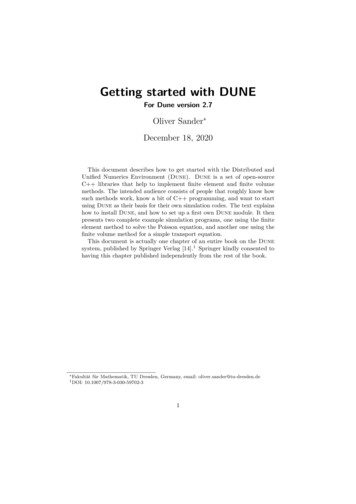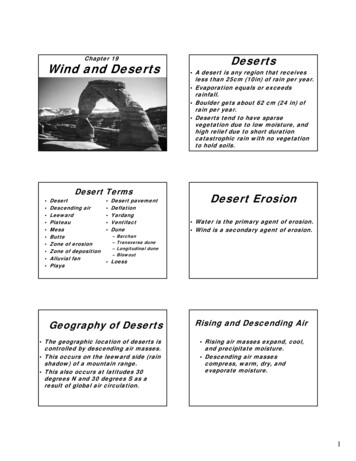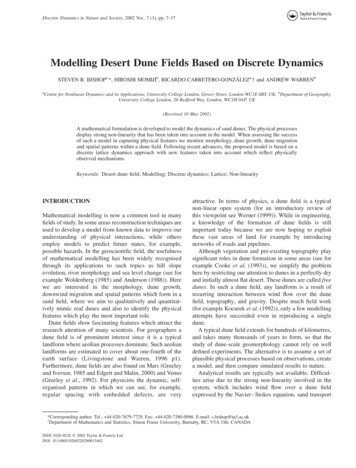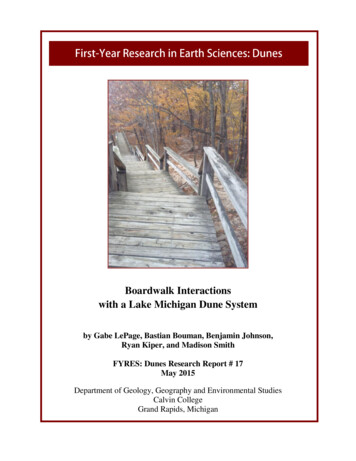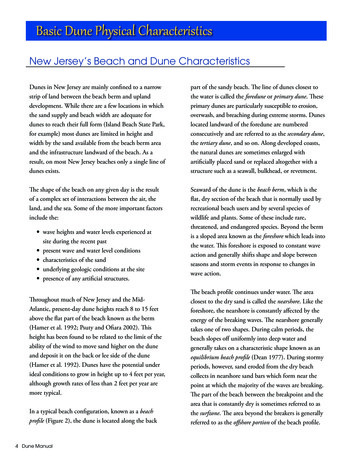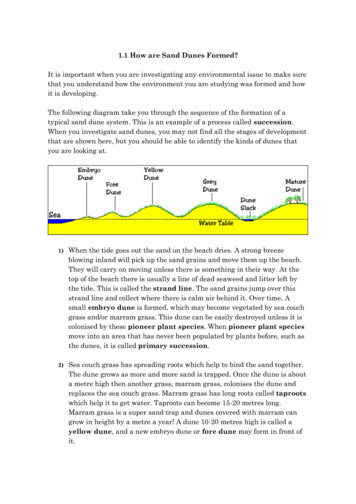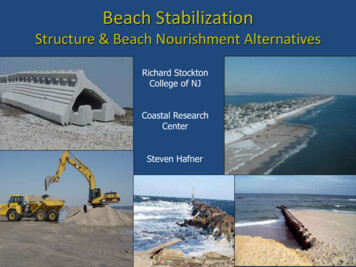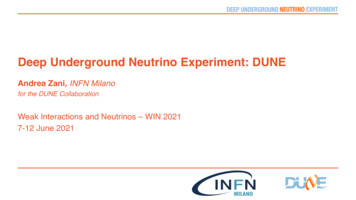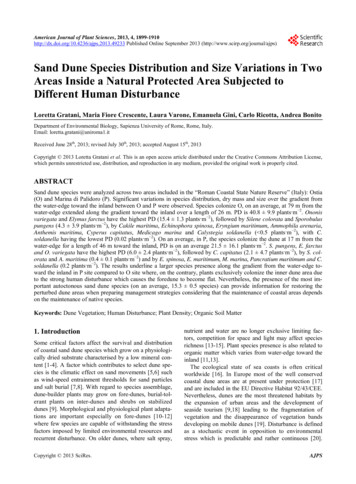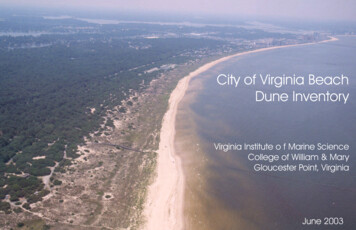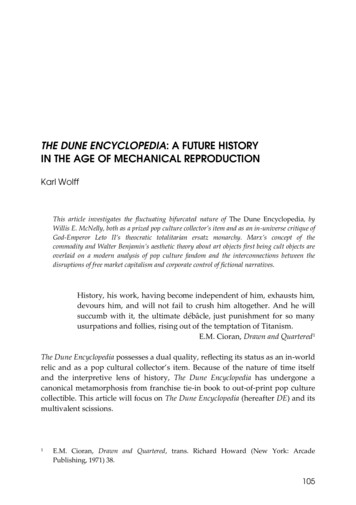
Transcription
THE DUNE ENCYCLOPEDIA: A FUTURE HISTORYIN THE AGE OF MECHANICAL REPRODUCTIONKarl WolffThis article investigates the fluctuating bifurcated nature of The Dune Encyclopedia, byWillis E. McNelly, both as a prized pop culture collector’s item and as an in-universe critique ofGod-Emperor Leto II’s theocratic totalitarian ersatz monarchy. Marx’s concept of thecommodity and Walter Benjamin’s aesthetic theory about art objects first being cult objects areoverlaid on a modern analysis of pop culture fandom and the interconnections between thedisruptions of free market capitalism and corporate control of fictional narratives.History, his work, having become independent of him, exhausts him,devours him, and will not fail to crush him altogether. And he willsuccumb with it, the ultimate débâcle, just punishment for so manyusurpations and follies, rising out of the temptation of Titanism.E.M. Cioran, Drawn and Quartered1The Dune Encyclopedia possesses a dual quality, reflecting its status as an in-worldrelic and as a pop cultural collector’s item. Because of the nature of time itselfand the interpretive lens of history, The Dune Encyclopedia has undergone acanonical metamorphosis from franchise tie-in book to out-of-print pop culturecollectible. This article will focus on The Dune Encyclopedia (hereafter DE) and itsmultivalent scissions.1E.M. Cioran, Drawn and Quartered, trans. Richard Howard (New York: ArcadePublishing, 1971) 38.105
Karl WolffAn important valence is DE’s importance within the Original Series itself.2Due to the vagaries of the franchise’s revival, the publishing industry, and thetext itself, DE operates as a Borgesian intellectual relic (within the DuneUniverse) and coveted collector’s item for bibliophile and Dune fan alike.This article seeks to mine meanings from the twin readings of the DE. Is theremore that can be investigated beyond the superficial monetary assessment of theDE’s fair market value as an exchangeable commodity? Since the DE was writtenas an in-world primary document, the Marxist-materialist reading only goes sofar in illuminating the encyclopedia’s appeal to the Dune fandom.The Dune Encyclopedia within The (Original) Dune SeriesThe DE was published in 1984, the same year as Heretics of Dune. The seriesbegan in 1965, very much a product of an emerging American eco-consciousnessand as a counterpoint to the Science Fiction New Wave. 3 Frank Herbertcontinued writing successive volumes up until his death in 1986. During thistime the world experienced the political, diplomatic, and military actions of theCold War.Below is the publication history of the Original Series, including DE. (NB: Allnovels in the Original Series are penned by Frank Herbert, except for DE.)4Dune (1965)Dune Messiah (1969)Children of Dune (1976)God Emperor of Dune (1981)DE (1984)Heretics of Dune (1984)Chapterhouse: Dune (1985)234The Original Series is my personal name for the novels of the series written by FrankHerbert: Dune, Dune Messiah, Children of Dune, God Emperor of Dune, Heretics of Dune,and Chapterhouse: Dune.The first three novels in the series (Dune, Dune Messiah, Children of Dune) unfold verymuch as a traditional epic narrative. They focus on court intrigue, military battles, anddynastic struggle.“Dune (franchise),” Wikipedia, https://en.wikipedia.org/wiki/Dune (franchise), accessed19 December 2019.106
The Dune EncyclopediaWhen he died, Frank Herbert left notes for an anticipated sequel to Chapterhouse:Dune. Untitled, it is simply referred to as Dune 7. The two novels coming out ofHerbert’s notes were:Hunters of Dune (2006)Sandworms of Dune (2007)Brian Herbert and Kevin J. Anderson revived the Dune franchise with a series ofprequels released as interrelated series. As of 2019, the Herbert/Andersoncollaborative prequels are:Prelude to Dune series:House Atreides (1999)House Harkonnen (2000)House Corrino (2001)Legends of Dune series:The Butlerian Jihad (2002)The Machine Crusade (2003)The Battle of Corrin (2004)Heroes of Dune series:Paul of Dune (2008)The Winds of Dune (2009)Great Schools of Dune series:Sisterhood of Dune (2012)Mentats of Dune (2014)Navigators of Dune (2016)The DE stands unique in the series because it functions as an archaeology andcommentary on the Empire, specifically as administered by Emperor Leto II. Thefact that Frank Herbert allowed another author to simultaneously expand andvivisect his imaginative creation also represents a fascinating literary107
Karl Wolffcollaboration. In the process, Herbert, the creator, becomes a common reader likehis fans.The Dune Encyclopedia as a Lost Text: The “Tlön” of the Dune FranchiseI owe the discovery of Uqbar to the conjunction of a mirror and anencyclopedia.Jorge Luis Borges, “Tlön, Uqbar, Orbis Tertius”5Despite the DE being out of print and its status as a non-canonical text, it is stillimportant to the overarching narrative of the Dune series. This significancebecomes reified by its “lost” status, itself a reflection of the DE as a product ofarchaeological discovery.It now remains “lost,” known only to collectors and canonicalfundamentalists. While the Expanded Dune novels have worked to growanother generation of fandom, older fans of the series will pursue the purchaseof the DE.6 Otherwise the DE will seem like nothing more than a curiousfootnote in a stubbornly analog format.The changing media landscape has also made purchasing this pop cultureartifact unnecessary. For certain entries, the Dune Wikia has a section devoted tothe DE entry and another to the Expanded Dune continuity. Although, to be fair,this dual-entry encyclopedic practice is far from comprehensive, complete, orconsistent. Even with a properly administered Wikia, the DE has not beenuploaded in its entirety. The Wikia itself divides the Dune canon into threesections: Original Dune, Expanded Dune, and the DE.7The DE acts as a kind of narrative bridge between the Original Dune andExpanded Dune. Much of the raw material for the Expanded Dune can be foundin the DE, albeit in a perfunctory, embryonic form.Because of time’s effect on the interpretation of the Dune canon, the DE canbe seen as a ghola.567Jorge Luis Borges, Collected Fictions, trans. Andrew Hurley (New York: Penguin Books,1998) 68.In its own way, the Brian Herbert/Kevin J. Anderson collaborations of the ExpandedDune franchise functions as a kind of “historical fiction” to the DE’s intellectualmission. The new novels have focused on the Great Houses, the Butlerian Jihad, andthe Mentats (among other topics). These same subjects have major entries in the DE.Dune Wikia homepage, https://dune.fandom.com/wiki/Main Page, accessed 19 December2019.108
The Dune EncyclopediaThe Dune Encyclopedia as Ghola Text: From Series Tie-in to Dune WikiaSupplementIf we say that, as values, commodities are simply congealed quantitiesof human labor, our analysis reduces them, it is true, to the level ofabstract value, but does not give them a form of value distinct fromtheir natural forms.Karl Marx, Capital8Over the course of the ensuing decades since its initial publication, the DE hasundergone a series of transformations. Time acts as the grain of sand upon this“simple congealed quantity of human labor.” The book itself has remained thesame in terms of textual content, but the surrounding changes in the pop culturallandscape have altered its importance and market value.The DE resembles one of the franchise’s major character(s), Duncan Idaho.Idaho underwent countless biological incarnations as a ghola, the Duneequivalent of a clone, serving different regimes and factions. Whether each gholarepresented the true Duncan Idaho or was a unique individual is a topic best leftto armchair philosophers and technicians of identity.9 (In the case of this article,the Duncan Idaho ghola serves as a metaphorical concept; a vessel for anextended thought experiment.)From 1984 to 1999, the DE was a franchise tie-in. In 1999, Herbert andAnderson began fleshing out the prequels. From 1999 to the present, the DE wasa non-canonical anomaly. When the Dune Wikia went online in August 2005, theDE metamorphosed into a supplementary repository of knowledge. Stillirrelevant in the Herbert/Anderson timeline, the DE functioned more as alternatehistory.108910Karl Marx, Capital: A Critique of Political Economy, vol. I, trans. Ben Fowkes (London:Penguin Books, 1990) 141.Like the DE itself, Duncan Idaho ceased being reproduced after the Fall of Leto and thecollapse of the Empire. He became, as it were, “out of print.” (Disallowing anyreproductions seen in the Brian Herbert/Kevin J. Anderson sequels based on FrankHerbert’s Dune 7 notes.)A real world parallel would be the schisms between the Church of Jesus Christ ofLatter-day Saints (LDS, a.k.a. the Mormons), the Reorganized Latter-day Saints(RLDS), and the Fundamentalist Latter-day Saints (FLDS). In terms of publicperception in the United States and the world, the LDS is the “official church”originating in the prophecies of Joseph Smith, Jr. and forward to the present Prophet,Seer, and Revelator of the Mormons. The LDS abandoned polygamy in the 1890s and109
Karl WolffThe non-canon status illuminates the differences between a pop-culturalproduct owned by a corporate entity and historical interpretation of non-fictionalevents. Does the non-canonical status imply an inherent incorrectness? It iswrong to interpret events in the Dune Universe with the DE? By way of contrast,The Rise and Fall of the Third Reich, by William L. Schirer gained fame as the firsthistorical account of the Third Reich. Despite the vast cottage industry of ThirdReich history, Shirer’s book still holds value, in part because of his status asjournalist-historian and witness to several of the events. New developments inThird Reich historiography do not invalidate the book, although certainpremises forwarded by Shirer have been disproved or discredited. The DE’sstatus as corporate-owned commodity complicates the picture. Is historicalinterpretation bound by the singular valence of who (or what) owns it? 11The Dune Encyclopedia as Forensic Reconstruction of History and anInstitutional Critique of Theocratic TyrannyL’etat c’est moi.Louis XIV [attributed]11accepted African Americans into the priesthood in 1979. The RLDS accepts a differentprophetic lineage. The FLDS still practices polygamy (illegally in the United States).But which schism of the Mormons represents the ‘real’ Latter-day Saints? Whichversion is deemed acceptable? And acceptable by whom? The same kind of schismsoccur within pop cultural fandom. This can occur with conflicts between fandom andthe ‘official’ corporate licensed property. Because of corporate imprimatur and thecapital (and legal teams) to back it up, the corporate property becomes the ‘official’content. Capital and corporate power alters the lens of public perception. How pop ispop culture?A different situation occurred when the Disney Corporation acquired Lucasfilm in2012 (the corporate entity responsible for Star Wars and its associated cinematic andmerchandising content). After the acquisition, Disney decided to abandon the StarWars Extended Universe. Disney has also acquired additional pop-cultural propertiesincluding Marvel (2009), Pixar (2006), and the Muppets (2004). This presents an ethicaland economic challenge to fans. On the plus side, all the characters are now under onecorporate umbrella. On the negative, do you really want the Disney Corporationmaking all your entertainment decisions for you? Then again, citizens of the UnitedStates should be used to the silver-tongued promises of monopoly capitalism andcorporate oligarchy. This is merely the economics of American healthcare translated tothe vagaries of pop culture.110
The Dune EncyclopediaIn the beginning was the Word, and the Word was with God, and theWord was God.John 1:1As an in-world primary document, the DE can be read as an institutional critiqueagainst the theocratic tyranny of Emperor Leto II. Published after God Emperor ofDune (1981) and concurrently with Heretics of Dune (1984), it functions as a caesurawithin the series. With the DE, Herbert pivoted his space opera into newer andstranger narrative trajectories.Unlike a novel, an encyclopedia need not be read in linear fashion. It servedas a repudiation of Emperor Leto II’s tyrannical rule, albeit from the perspectivesof archaeologists and encyclopedists. The chronology states that “Thepublication of THE DUNE ENCYCLOPEDIA” occurred in 15540.12 Emperor LetoII reigned from 10219 to 13724. Prior to the DE publication, there was thediscovery of the Rakis Hoard in 15525.Despite the series taking place in a far future, the DE’s perspective of Leto II’sreign is from that of the ancient past. It is equivalent to writing an encyclopediaof the Roman Empire from the perspective of the present.Due to the sheer volume of recorded matter to translate, classify, and interpret,the DE is not the final word on the Dune Universe.13 Mainly because no final wordhad been written at the time of publication. The task was simply too huge.Additionally, the practice of history is not about establishing the final wordso much as supporting an interpretation with evidence. The DE’s encyclopedicform makes it possible to arrive at multiple valid interpretations.It was apparent that scholars faced an archaeological discoveryunparalleled in magnitude in the history of mankind. The First DiscoveryConference, held on Geidi Prime, met only to establish an agenda for the1213A note on chronology: The Dune franchise does not use BCE/CE but B.G. and A.G.meaning “Before Guild” and “After Guild.” The creation of the Spacing Guild withtheir monopoly on space travels serves as the epochal moment for a new system ofreckoning. The Guild existed before the Empire and is entirely dependent on the spicemélange, which only exists on Arrakis. Unlike other systems of reckoning like BC andAD, it is entirely economic in nature and an economics whose commodity dependenceacts as both a stabilizing factor and as a fulcrum for conflict. If the Guild does not havea reliable source for spice, then there is a very real possibility that the Empire couldcollapse.The Dune Universe means the pre-Imperial, Imperial, and post-Imperial worlds, theirinhabitants, technology, etc. On a materialist level, the very stuff of culture.111
Karl Wolffplanning of the investigation of the find. The Second DiscoveryConference, held on Rakis itself, spent a full two years in deciding onprocedure and a cataloging system, and, as it turned out, that system wasnot without flaws.14What we have here is like finding the Library of Alexandria, except several timeslarger in sheer size. The DE is the first fruits of this labor. Like the Terranexplorers of the early modern era, what they discovered were not continents, butcontinents of raw data. Even the survey and inventory of aforementioned datawould be a heroic task.As the editor Hadi Benotto states in her Introduction, “[I]t [the DE] is notdesigned as a definitive study of the entire era encompassed by the AtreidesImperium. [ ] In addition, we must also consider something of the eccentricitiesof Lord Leto, who was solely responsible for accumulating, assembling, andsecreting what is now known as the Rakis Hoard.”15While the Empire had its share of benevolent and despotic emperors, LordLeto puts a new fold on the concept of imperial rule. The history of the DuneUniverse is bracketed by two jihads: the Butlerian Jihad and the Fremen Jihad.The Butlerian Jihad waged war against the thinking machines with mankindtriumphant. The Fremen Jihad occurred following the accession of PaulMuad’Dib to the throne. What follows was a war of genocide, politicalconsolidation, and religious uniformity. As Emperor Paul Muad’Dib himselfrecords, “Statistics: at a conservative estimate, I’ve killed sixty-one billion,sterilized ninety planets, completely demoralized five hundred others. I’vewiped out the followers of forty religions[.].”16Between the reign of Paul Muad’Dib and his son Leto, Paul abandons thethrone and exiles himself. His sister Alia acts as regent until the future Leto IIcan come of age. Her reign ends in disaster and Leto himself wanders into thedesert after attaching sandworms to his body.Paul and Alia ruled with the all the foibles and weaknesses endemic ofhumans. Even though both possessed remarkable mental abilities (in large partdue to the psychotropic effect of the spice melange), they were still bound by the141516Willis E. McNelly, “Bibliography,” The Dune Encyclopedia (New York: Berkley Books,1984) 517 – hereafter referenced as DE.Hadi Benotto, “Introduction,” DE vi.“Fremen Jihad,” DE 232.112
The Dune Encyclopediarestrictions of a human body and a human mind. Paul’s son Leto upended theserestrictions, going on to rule the Empire for 3500 years.17Due to his hybrid nature (part-human, part-sandworm), Lord Leto possessedan inherited collective consciousness and psychic abilities. In God Emperor ofDune, he kills off historians,18 since their power to interpret the past posed athreat to his rule. Only he could interpret the past, since he was in directcommunication with ancestral figures stretching back thousands of years. TheDE attempts to repair these tyrannical acts. Replete with multiple interpretationsand multiple perspectives, the DE does its best to comprehend anincomprehensible ruler.Reading the DE invites free-associative narrative journeys, one entry leadingto another entry, etc. A narrative is constructed, but it is Heraclitean, amorphous,and subjective.19 This stands in opposition to Lord Leto’s rule. His long rule,intimidating biological form, and charismatic personality further sharpened theImperial concept of tyranny. Paul Muad’Dib’s theocracy evolved into LordLeto’s monomaniacal dictatorship.In most cases tyrants and dictators die. With Lord Leto there is not evendynastic succession, since he outlives everybody. He combines this by turningthe Fremen Buddhislamic religion into his own Cult of Personality. He is not thevicarious representative of god, as are absolute monarchs, but he is god. In theprocess, he creates a corpus of female bodyguards and he begins a breedingprogram.20 His authoritarian activity is all done in the name of achieving theGolden Path, a mystical concept whereby humanity will be freed of psychic17181920Emperor Leto II remains one of the most fascinating characters in literature. While thisarticle is limited in its scope and length, it would be worthwhile to devote amonograph-length exploration to Lord Leto. Briefly, Lord Leto blurs the distinctionbetween self and other, individual and collective, and human and animal. Thedramatic nature of his reign alters the narrative trajectory of the Dune series and hisprolonged rule annihilated a political system that had stood for 10,000 years.In 12335 there is “The execution of THE NINE HISTORIANS”; see “A Chronology ofSome Important Events in Human History,” DE ix.A similar reading experience occurs in Chris Ware’s Building Stories (2012). Comprisedof several mini comics of various sizes and formats, the multiple narratives revolvearound the inhabitants of a building in Chicago. No guide or sequence is provided forthe various mini comics. The reader must choose and no two readers will choose thesame order.His female bodyguards, the Fish Speakers, echo Colonel Muammar Gaddafi’s cadre offemale bodyguards. Regarding his breeding program, he usurped this power from theBene Gesserit.113
Karl Wolffmanipulation.21 But his attempts at breeding spontaneity within humanitycollapses because it is an intellectual paradox. Humans cannot be free to thinkfor themselves when the Emperor does all the thinking for them.Lord Leto is eventually assassinated and the Empire collapses along withhim.22 The Post-Imperial epoch involves the Starvation and the Scattering. TheDE is an attempt to assemble the fragments of a shattered system that had ruledfor thirteen millennia.The Dune Encyclopedia as Collector’s Item: Canon and CommodityFetishismA commodity appears at first sight an extremely obvious, trivial thing.But its analysis brings out that it is a very strange thing, abounding inmetaphysical subtleties and theological niceties.Karl Marx, Capital23The DE’s permanent out-of-print status has made the DE an appealing item tobibliophiles and Dune fans. After the revival of the Dune franchise, thepublication of the prequel books made the DE more and more narrativelyirrelevant, albeit more financially valuable. The friction generated from opposingvalences (worthless vs. valuable) is echoed by another opposing set of valences(in-word document vs. real world pop culture tie-in product).Another important consideration is Dune’s status as an adult science fictionfranchise.24 Since the franchise is not aimed primarily at a juvenile market (cf.Star Wars), the commercial output lacks in sheer metric tonnage. Lacking tie-intoys, action figures, and other related merchandise, any item relating to Duneaccrues added value.252122232425“You cannot plan to breed humanity into some higher type and at the same time givehumanity the essential freedom which is supposedly at the heart of the Golden Path,”DE 68.However, even death cannot defeat Lord Leto. Rumors abound about how the postLetan sandworms each contain a part of Lord Leto’s ego, new beings created viainterspecies metempsychosis.Marx 163.We may add a third set of opposing valences (obscure vs. well-known) when setagainst other pop culture franchises.Star Wars is the most egregious exemplar of this trend, especially in light of Disney’sacquisition of the creative property, and the much-touted release of films relating to theconclusion of the original trilogy. While the entertainment business is still a business, the114
The Dune EncyclopediaIn addition to these real world market considerations,26 we can’t ignore thebookishness of the DE. The Dune franchise’s uniqueness also lay in its worldbuilding. One of the major historical events in the Dune Universe was theButlerian Jihad. This crusade sought to destroy “thinking machines” resulting ina technophobic27 interstellar political empire.As time has crept by, the world has become entranced with “thinkingmachines,” be they smartphones, satellite navigation, eBooks, Alexa, andAmazon algorithms. Amid all these glowing rectangles and soothing voicesguiding us along the road or towards the next purchase, it becomes a challengeto remember the value of a book. Not merely its monetary value, but its materialvalue: its weight, feel, look, and smell. While print is assuredly not dead, its life isthreatened in an age of over-abundant choice and maximum distraction.The book’s monetary value can be set against the sensualism and intellectualstimulation aroused by this unique pop cultural artifact. As stated above, theappreciation of the DE involves an applied sensuality, not simply the satisfactionof owning something of high monetary value. Its price point is merely amaterialist quantum, a set of numbers on a constantly changing grid of valueand demand. Focusing on how much it costs only exemplifies the utteremptiness of pricing. The DE is much more than that.Because of the technophobic nature of the Dune Universe, the DE wouldhave to exist as a print book. Even the illustrations are hand-drawn and have acharming simplicity. The DE hearkens back not only to an analog mentality, butone that values to manual production. In its own idiosyncratic way, the DEpossesses a quality akin to artisanal handicrafts.2627near-infinite amount of price points has become fuel for both comedians and culturalcommentators. “Spaceballs: the breakfast cereal, Spaceballs: the flame thrower the kidslove this one.”As of 14 August 2019, the DE represents this value in American dollars ( ) on thesethree popular websites: Amazon.com: 245.55 – 912.89; Abebooks.com: 150.00 – 878.35; Ebay.com: 75.00 – 143.95 (softcover) [Cheapest to most expensive ofhardcover edition. For the sake of general illustration, the condition is not beingconsidered.]. NB: Prices are listed for demonstration purposes only. The point is toconfirm the commonly accepted fair market value of the book as an exchangeablecommodity.The Imperial technophobia is specifically targeted at sentient technology, notnecessarily all technology. The Empire ruled with an indirect hand in most matters,leaving it to the noble houses of the Landsraad to administer their planets in agovernor-like capacity. Unafraid to use atomic weapons, the Empire possesses theintellectual know-how to use advanced weapons of mass destruction. While fearful ofartificial intelligence, the elites of the Empire were not Luddites.115
Karl WolffWalter Benjamin states: “Originally the contextual integration of art intradition found its expression in the cult. We know that the earliest art worksoriginated in the service of a ritual – first the magical, then the religious kind.”28Extrapolating Benjamin’s assertion, pop-cultural fandoms operate as cults.Shared rituals and traditions dominate fandom discourse, each with their ownschisms, fanatics, and toxic elements.Because of its limited production, the DE has become a cult object “aboundingin metaphysical subtleties and theological niceties.”Irony of ironies is that the DE has acquired the status as a cult relic amongthe Dune fandom. Ironic because the DE existed in the realm of mass marketpublishing. A hardcover and paperback edition were issued. The skyrocketingprices as an out-of-print book further accentuate its cult object status. Yet, at thesame time, the Dune Wikia has short-circuited an otherwise the exclusionaryeconomics in the world of book collecting.Once prices inhibit swaths of socioeconomic strata, is the object simply aWhite Whale to be captured, or has the object lost its meaning as a vehicle forindividual enjoyment? Contemporary fandom discourse has debated the conceptof “gatekeepers.” The term usually refers to white males who still think theyown everything. Could this term also be applied to pop-cultural productionsthat can exclude fans, new or otherwise, simply because it is too expensive? 29Conclusion: A History in FragmentsAs a concept, the encyclopedia is a work that holds an institutional imprimatur.The size and scope of encyclopedias evoke the construct of an organizationalauthority. A repository of knowledge and a storehouse of data, the encyclopediainvites reactions ranging from curiosity to awe. In the case of the DE, itrepresents a first attempt at interpreting a monumental storehouse ofknowledge. It attempts to scaffold a voice of authority in an era of decentralizedchaos and fragility. It attempts to answer the question, “How did we get into thismess?”2829Walter Benjamin, “The Work of Art in the Age of Mechanical Reproduction,”Illuminations, trans. Harry Zohn (New York: Schoken, 1969) 223.As a means of comparison, the current 5th Edition of Dungeons & Dragons seeks toappeal to a public, vocal, and diverse fan base. The base price for game elements likemanuals and rulebooks are set at 50.00 each. Or, to use a Simpson’s sight gag, “OurPrices Discriminate Because We Can’t.” The sign from the Springfield HeightsPromenade, an upscale mall in Springfield Heights; Springfield Heights Promenade,Simpsons Wikia, https://simpsons.fandom.com/wiki/, accessed 14 August 2019.116
The Dune EncyclopediaBeyond its function as an in-world publication, the DE has been relegated tothe dustbin of history due to the revival of the Dune franchise. It won’t bepublished again, although it lives on in entries on the Dune Wikia and in thehands of a bibliophilic elect.Because it will never again be published, a Benjaminian aura halos the books.Due to its non-reproducibility, it becomes a target for commodity fetishism andcultist adoration. The book radiates a different kind of material specialness, thistime in the hands of pop culture aficionados and Dune fans.117
sections: Original Dune, Expanded Dune, and the DE.7 The DE acts as a kind of narrative bridge between the Original Dune and Expanded Dune. Much of the raw material for the Expanded Dune can be found in the DE, albeit in a perfunctory, embryonic form. Because of times effect on the interpretation of the Dune canon, the DE can be seen as a ghola.

